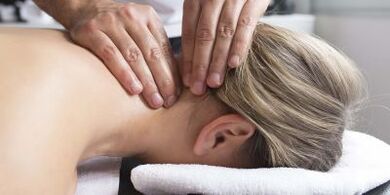
Now there are practically no people over 25 who do not have problems with the spine. One of the most common pathologies is the damage to the vertebrae of the neck, which, if left untreated, inevitably develops and causes the patient more and more discomfort.
What is osteochondrosis?
Osteochondrosis of the cervical spine is a degenerative-dystrophic change in the joints and intervertebral discs.
As cervical osteochondrosis progresses, the following symptoms begin to appear:
reduced visual acuity and hearing.
numbness of the tongue.
with a sharp turn of the neck, darkens the eyes, dizzy.
in the back of the head, he feels a throbbing pain, which may radiate to the temples and crown.
pain in the cervical spine and shoulders, disturbing the patient even during sleep and aggravated by movement or exercise.
stiff neck, especially in the morning.
sternal pressure.
shortness of breath, feeling short of breath.
Due to the fact that the spinal cord does not receive enough nutrients, the range of motion, as well as the sensitivity of the upper and lower limbs, is significantly reduced.
Causes of cervical osteochondrosis
The predisposition to neck osteochondrosis is hereditary. In addition, the common causes of the development of pathology are:
unbalanced diet;
scoliosis
flatfeet;
VSD?
stress;
spinal injuries and bruises.
excessive physical activity.
rheumatism;
sedentary life?
overweight.
Report! The main reason for the development of osteochondrosis is the violation of mineral metabolism, which may be associated with a lack of calcium or a hormonal disorder. Women often experience this pathology during pregnancy and menopause.
Diagnostics
The following diagnostic methods are used to determine the degree of degenerative changes in the spine:
Doppler ultrasound of the carotid artery and vertebral arteries. It allows you to locate spasmodic vessels, as well as violation of the blood supply to the brain and spinal cord.
Audio to control the function of the hearing organs.
Ultrasound.
Computed tomography and magnetic resonance imaging of the head and cervical spine. It is performed in order to assess the area of the lesion, to check the position of the intervertebral discs, to detect compression of the spinal cord and blood vessels.
Blood test.
X-ray at an early stage of pathology.
Electron neuromyography showing the presence of inflammation, stinging and nerve damage.
Double scan of the vessels of the head.
Report! All these procedures are made more convenient in one place, for example, in a treatment and rehabilitation center, where diagnostics are performed with modern equipment.
Which doctor treats
If symptoms of cervical osteochondrosis occur, you can not start treatment right away. First of all, you need to make an appointment with a neurologist. The specialist will perform an examination and then refer the patient to the necessary studies.
Great! Performing manual therapy and other types of treatment without a preliminary diagnosis threatens injuries and worsens existing problems.
Treatment methods
Once the diagnosis is made, the patient can proceed with treatment. Top specialists work in treatment and rehabilitation centers, so the possibility of complications is minimal.
The main method of treating osteochondrosis of the neck is manual treatment. The specialist does a massage that relaxes the neck and shoulders, returns the vertebrae and joints to their natural position and works to normalize lymph flow and blood circulation.
Manual therapy is often combined with therapeutic exercises to stimulate the neck muscles. In addition, medication and physiotherapy are used to get rid of the pathology.
Results
As a result of the treatment, the nerve endings are freed from the sting, the spine is stabilized and the pain disappears or is reduced. A chiropractor is able to straighten the vertebrae and increase the distance between damaged discs, thus eliminating friction.
Great! Grade 2 and 3 osteochondrosis cannot be completely cured. But treatment and rehabilitation will allow the patient to restore reduced spinal function as much as possible.
Restoration and restoration of lifestyle
In the treatment and rehabilitation centers, not only the diagnosis and treatment of cervical osteochondrosis is performed, but also rehabilitation measures. The patient leaves the center healthy and ready to return to his normal lifestyle as soon as possible.
Rehabilitation is not only aimed at restoring the function of the spine, but also at preventing damage to healthy tissues. The program is prepared taking into account the severity of the pathology and the presence of complications. Physiotherapy procedures, massage, exercise therapy, mud applications have proven to be good. If the patient still has symptoms of pathology, he is prescribed drug exclusion.
Lifestyle with cervical osteochondrosis
To prevent recurrence of the disease, the following recommendations should be followed:
change body position at least every half hour.
do not lift a load weighing more than 5 kg.
more walking, physical therapy, swimming, pilates.
it is better not to use a bag, but a backpack.
when sitting, take ten-minute breaks every hour.
Great! The position of the human body during sleep is very important. You should sleep on your back in an orthopedic mattress of medium stability and an orthopedic pillow. In this case, the head and neck should be on the pillow and the shoulders should be on the mattress.
The treatment of cervical osteochondrosis is more effective at an early stage, so you should not postpone the visit to a neurologist. However, it is possible to stop the progression of the disease and improve the quality of life regardless of the degree of damage to the joints and intervertebral discs. For this, it is important not to waste time and follow the recommendations of an expert.


















































